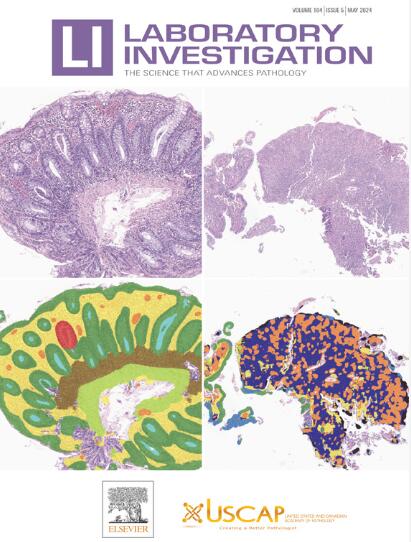Neoadjuvant Therapy–Associated CDX2 Expression and Its Prognostic Implication in Esophageal Adenocarcinoma
IF 5.1
2区 医学
Q1 MEDICINE, RESEARCH & EXPERIMENTAL
引用次数: 0
Abstract
Neoadjuvant chemoradiotherapy followed by surgery is the standard care for locally advanced esophageal adenocarcinoma. However, reliable postoperative prognostic biomarkers are still needed to stratify patients with different clinical outcomes. This study aimed to investigate postneoadjuvant expression changes of CDX2 and its association with histopathological features, biomarkers for targeted therapy, distant metastasis, and survival status. A total of 62 esophagogastrectomy specimens from one institution were evaluated. A tissue microarray was constructed, and IHC staining was performed. CDX2 expression was found in 27 (43.5%) cases with well-to-poor differentiation. Compared with preoperative biopsies, 68.8% of cases demonstrated induced or enhanced CDX2 expression. There were no significant differences in age, tumor location, histologic grade, lymph node metastasis, tumor stage, and treatment response between CDX2-positive and CDX2-negative groups. Neuroendocrine and Paneth cell differentiation induced by neoadjuvant therapy were more commonly seen in CDX2-positive cases. CDX2 expression was associated with higher multidrug resistance-1 and HER-2 expression. Patients with CDX2-positive diseases showed a higher risk of distant metastasis and a worse prognosis than those with CDX2-negative diseases.
食管腺癌新辅助治疗相关CDX2表达及其预后意义。
新辅助放化疗后手术是局部晚期食管腺癌的标准治疗。然而,仍然需要可靠的术后预后生物标志物来对不同临床结果的患者进行分层。本研究旨在探讨CDX2的新辅助后表达变化及其与组织病理特征、靶向治疗生物标志物、远处转移和生存状态的关系。我们对同一机构的62例食管胃切除术标本进行了评估。构建组织芯片,进行免疫组织化学染色。CDX2表达于27例(43.5%)分化良好至不良的病例。与术前活检相比,68.8%的病例CDX2表达被诱导或增强。cdx2阳性组与cdx2阴性组在年龄、肿瘤部位、组织学分级、淋巴结转移、肿瘤分期、治疗效果等方面均无统计学差异。新辅助治疗诱导的神经内分泌和Paneth细胞分化多见于cdx2阳性病例。CDX2的表达与较高的MDR1和HER-2表达相关。cdx2阳性患者远端转移的风险高于cdx2阴性患者,预后较差。
本文章由计算机程序翻译,如有差异,请以英文原文为准。
求助全文
约1分钟内获得全文
求助全文
来源期刊

Laboratory Investigation
医学-病理学
CiteScore
8.30
自引率
0.00%
发文量
125
审稿时长
2 months
期刊介绍:
Laboratory Investigation is an international journal owned by the United States and Canadian Academy of Pathology. Laboratory Investigation offers prompt publication of high-quality original research in all biomedical disciplines relating to the understanding of human disease and the application of new methods to the diagnosis of disease. Both human and experimental studies are welcome.
 求助内容:
求助内容: 应助结果提醒方式:
应助结果提醒方式:


